Christmas is for telling stories, even in museums. This story – the interrelationship of textiles, taste and commerce – is told with magnificence and aplomb by the Metropolitan Museum of Art’s dazzling, 10-room show, ‘Interwoven Globe: The Worldwide Textile Trade, 1500–1800’. Of the 134 pieces, mostly large, in mint condition and not exhibited before, two thirds are from the museum’s own vaults.
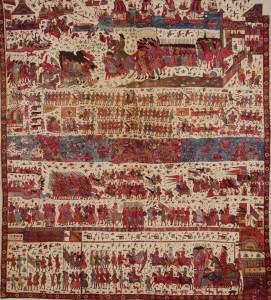
Hanging Depicting A European Conflict in South India, Probably the Siege of Pondicherry 1760–1, (after 1761), India (Coromandel Coast), for the English market Titi Halle/Cora Ginsburg LLC, New York
Once the post-Renaissance Europeans ramped up their navigation skills and sailed around the vastness of Africa to faraway places they had to find names for, the trade-controlling Venetians and Ottomans were bypassed and beaten. Big-time maritime trading took off, especially in textiles.
Luscious silks and fine muslin cottons were embroidered, painted or fancily woven expressly to be traded from one culture to another. Known as trading textiles, their production hub was India, already renowned for its top quality fabrics. They had long been currency for buying spices; now they were increasingly an essential tool in European interior design and fashion. It was not long before there emerged the first globalisation of style in textile design.
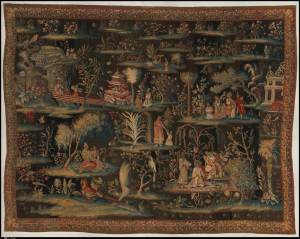
The Toilet of the Princess Attributed to John Vanderbank (active c. 1680–1717). Great Wardrobe tapestry workshop, London (1690–1715) The Metropolitan Museum of Art, Gift of Mrs. George F. Baker, 1953
The show’s first exhibits give a taste of this cross-fertilisation: a glowing mustard-gold quilt depicting a large Genoese trading ship (on its way to India or China, perhaps?); an Indian cotton block-printed with arabesques for the Egyptian market; another painted and dyed to suit Indonesian tastes; yet another embroidered with silk to please the Portuguese. Like the clothing store Zara today, different products were made for sale in different markets.
Masterpieces abound. One is a huge silk hanging made at Satgaon in Bengal, Eastern India, in the early 17th century. The image, tightly chain-stitched in white on a blue ground, shows a triumphal arch commemorating the arrival of Philip III of Spain in Lisbon in 1619, who ruled in Portugal as Philip II. Here is a Portuguese patron supplying an image for Indians to record, in a most refined way, a moment in his country’s history.
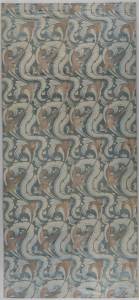
Length of Bizarre Silk (1700–10), France or Italy. The Metropolitan Museum of Art, Rogers Fund, 1964
Another is a ravishing bedcover of animals frolicking among strawberry-pink blossoms and delicate arabesques, was made a century later in Gujarat, Western India, for the English market. Here, we have English embroidery designs – themselves a local concoction of European, Indian and Chinese imagery – being sent out to their original source, where they are given an extra dash of Mughal court sophistication.
There is an abundance of floral imagery: geometric scarlet blossoms for the Japanese elite of the Edo period; a Japanese-style chintz of a fecund landscape for the Dutch market; a tree that blossoms roses and pineapples for the Sri Lankans. And, just to keep visitors sharp-eyed, some ‘bizarre silks’ like swirling Art Nouveau designs that were made in France, Italy, India and China, the cross-influences zipping back and forth on those merchants’ trading ships.
‘Interwoven Globe: The Worldwide Textile Trade, 1500–1800’ is at the Metropolitan Museum of Art, New York, until 5 January 2014.
Unlimited access from just $16 every 3 months
Subscribe to get unlimited and exclusive access to the top art stories, interviews and exhibition reviews.


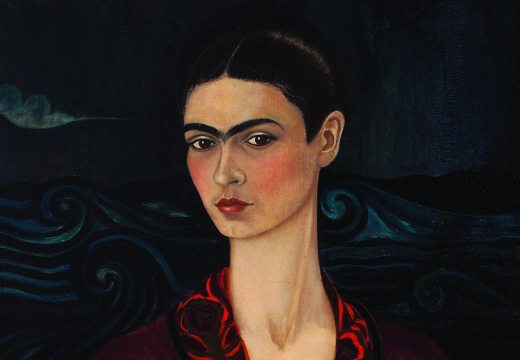
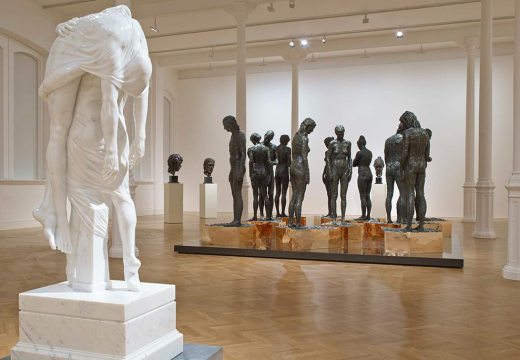










![Masterpiece [Re]discovery 2022. Photo: Ben Fisher Photography, courtesy of Masterpiece London](http://www.apollo-magazine.com/wp-content/uploads/2022/07/MPL2022_4263.jpg)
It’s time for the government of London to return to its rightful home